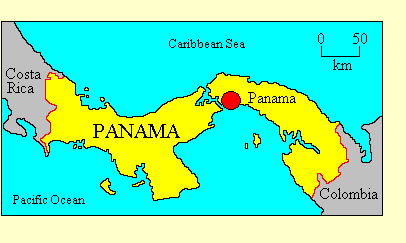
REPUBLIC OF PANAMA• Official name: Republica de Panama (Republic of Panama)
European and American investors were interested in building a canal across the isthmus from the 1840s. When a European attempt to do so ended in bankruptcy in 1889, the Americans moved in, and fostered a Panamanian secession movement to avoid Colombia's unending civil strife. In November 1903 Panama seceded from Colombia and became in effect an American protectorate. Under the Hay-Bunau-Varilla Treaty the United States annexed the Panama Canal Zone and gained the right to intervene in Panamanian affairs if the security of the Canal Zone was threatened. The canal was completed in 1914. 
Independent Panama has been plagued by instability and frequent American interventions in its affairs, although the formal right of intervention was renounced in 1936. Panamanian politics was dominated for many years by Arnulfo Arias Madrid, a nationalist who was President three times between 1940 and 1968. Nationalist demands centred on the return of the Canal Zone to Panama. Exploitation of this issue allowed the army commander Omar Torrijos Herrera to seize power in 1968 and retain it until 1981. In 1977 a new treaty restored Panamanian sovereignty over the Canal Zone, although Panama did not take over running the canal itself until 2000. Torrijos was succeeded as army boss and de facto ruler by Manuel Antonio Noriega Moreno in 1983. Through the 1980s Noriega manipulated elections, ruling Panama through puppet presidents. In December 1989, in the course of protests over election rigging, a US Marine was killed by Panamanian soldiers. The United States then invaded the country and removed Noriega from power. Guillermo Endara Galimany, elected to the presidency in 1989 but prevented by Noriega from taking office, took power. Since then democratic government has been maintained, and in 1994 the army was abolished. Panamanian political parties are grouped in two coalitions. The liberal Alliance for Change includes Democratic Change (CD), the Panamenista Party (PP), the Patriotic Union (UP) and the Nationalist Republican Liberal Movement (MOLIRENA). The left-wing One Country For All (UPPT) coalition is dominated by Torrojos's Democratic Revolutionary Party (PRD). Torrijos's son, Martin Torrijos, was President from 2004 to 2009. At the 2009 election, Ricardo Martinelli Berrocall of Democratic Change was elected President. Freedom House's 2009 report on Panama says: "Panama is an electoral democracy. The 2004 national elections were considered free and fair by international observers [as were the 2009 elections]... Corruption remains widespread, and 2006 electoral reforms have been criticised as lacking key elements to improve transparency, especially regarding campaign financing... Panama was ranked 85 out of 180 countries surveyed on Transparency International's 2008 Corruption Perceptions Index... All of the country's media outlets are privately owned, with the exceptions of the state-owned television network and a network operated by the Roman Catholic Church... Freedom of assembly is recognized, and nongovernmental organisations are free to operate... The judicial system remains overburdened, inefficient, politicised, and prone to corruption." Updated July 2010 |
